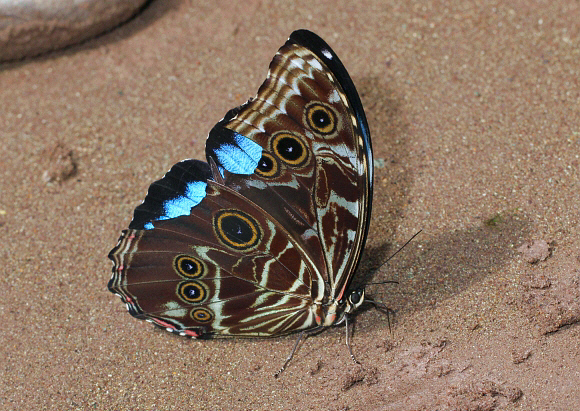
Introduction
It is a source of amusement to lepidopterists that the general public in Latin America always refer to every one of the Morpho species as if they were just one creature – “the Blue Morpho”. There are in fact at least 29 described species, possibly more, as the status of some subspecies is contended by some taxonomists who consider they should be elevated to the rank of full species.
The dazzling blue wings of Morpho butterflies are enormous relative to their body size, resulting in a very distinctive slow, bouncy flight pattern. The effect is that the brilliant blue upperside appears to flash like a beacon as it alternates in flight with the dark undersurface. This makes it difficult for a bird to follow the flight. If attacked when on the wing, the slow lazy flight pattern instantly changes into a wild swooping evasive manoeuvre, following which the butterfly dives into the forest where it instantly settles. A pursuing bird is still of course searching for a brilliant blue insect, but the Morpho snaps its wings shut, displaying the dark brown underside and foiling the bird’s search program. If the bird does manage to spot the settled butterfly it invariably aims its attack at the most prominent feature – in this case the ocelli, missing the body entirely and allowing the butterfly to escape.
The intense dazzling blue colour of Morpho butterflies is impossible to convey in a photograph. The words used by DeVries to describe Morpho cypris are very apt: “The sight of this sailing blue orb against a rainforest background is truly one of the most stunningly beautiful in the neotropics”. The legendary naturalist Henry Walter Bates described the shimmering blue hues of the Morpho equally well: “When it comes sailing along it occasionally flaps its wings and then the blue surface flashes in the sunlight so that it is visible a quarter of a mile away”.
Morpho deidamia is a widespread but uncommon species found throughout the neotropical region from Nicaragua to Bolivia.
Habitats
This species is adapted to breed in a wide variety of forested habitats, occurring for example in the dry deciduous woodlands of Nicaragua, but is far more often encountered in primary rainforest. It is found at altitudes between 0-1400m.
Lifecycle
I have no data specific to deidamia. The eggs of most other Morpho species are dome-shaped and pale green with a narrow reddish ring near the top. Most Morphos lay apparently their eggs singly but several Morpho species have gregarious larvae, strongly suggesting that their eggs are laid in clusters. Fully grown larvae are plump, with a large head. Their bodies are beautifully patterned with fine longitudinal lines of bright red, yellow and black, and covered with fine brown hairs which are tufted near the head and tail, and in the middle of the back. Morpho larvae feed on the leaves of a wide range of trees in the family Fabaceae including Macharium, Pterocarpus, Lonchocarpus, Swartzia and Dalbergia. The larvae have eversible glands on the thorax which emit a strong odour as a defence against predators. The pupae are pale green and bulbous, and are suspended from a stem or leaf of the foodplant.
Adult behaviour
Males patrol back and forth along the courses of streams and rivers in the dappled sunlight of their forest habitats. On sunny and warm afternoons they can sometimes be found imbibing mineralised moisture from damp sand, or from urine-tainted ground. If disturbed they tend to fly a short distance and settle among the foliage of a nearby tree or bush, but will often return to feed after they sense the danger has passed. Females are seen far less frequently.
Both sexes close their wings immediately upon landing, but periodically flick them open to give the briefest glimpse of the dazzling blue upperside. This behaviour is most pronounced in mud-puddling males, which repeatedly flicker their wings as they hop about on the ground seeking dissolved minerals.
